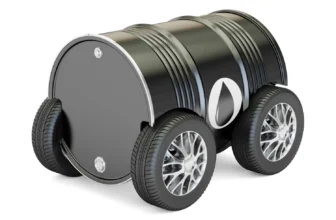
Understanding the Suspension System
1.1 What Does It Do? Your vehicle’s suspension system is one of the most critical components that ensure you enjoy a smooth ride. As the name suggests, it suspends your car above the wheels. At its core, the suspension system helps keep your car’s tires in consistent contact with the road, which is essential for stability, control, and braking performance. Without it, you’d be feeling every bump, pothole, and imperfection in the road. Moreover, it’s crucial for even tire wear, ensuring you get the most out of your *tyres. Another component you’ll often hear alongside the suspension is:
Shock absorbers: These do exactly what their name implies; they absorb the shocks and vibrations that arise from road imperfections. When you hit a bump, your car’s weight transfers to the wheel that hit it, causing the spring to compress. The shock absorber then comes into play by dampening the spring’s rebound, ensuring a smoother transition for the rest of the car.
Comprehensive Car Maintenance & Repair Guide can give you a deeper insight into the importance and functioning of suspension systems. The role of suspension in ensuring a pleasant driving experience cannot be understated.
1.2 Common Suspension Problems
Now, identifying potential suspension problems is crucial. While a well-maintained suspension systems can last many miles.
Here’s what you should watch out for:
Uneven tyre wear tyres too quickly, or unevenly: This can be due to a host of issues, but most commonly, it’s sagging springs or worn shocks. If your car’s suspension isn’t doing its job, the tires will take the brunt of the impact, leading to uneven wear.
Excessive bouncing: If your car bounces more than once or twice after hitting a bump, there’s a likely issue with your shocks.
Unstable steering: A stiff or erratic steering wheel can often be traced back to suspension problems. Worn ball joints, tie rods, or damaged control arms can all contribute. Member that maintaining a top-notch suspension system ensures you have utmost control over your car. Need a deeper div ck into the mechanics of suspension? Dive into Connecting with Your Car: Insights for New Car Owners and Cooling System and Radiator Care.
Mastering Steering Checks
Steering is the lifeline of your car, determining how effectively you navigate the roads. In this section, we will delve into the intricacies of steering systems, empowering you to master steering checks and ensure a safe and smooth driving experience.
2.1 The Basics of Steering Systems
Understanding how your car’s steering system operates is the first step in efficient car maintenance and repair. There are two primary types of steering systems: power steering and manual steering.
- Power Steering: Power steering is a modern convenience that uses hydraulic or electric systems to assist the driver in turning the steering wheel. The power steering fluid, pump, and hoses play pivotal roles in this system. The fluid serves as the medium for transmitting power, the pump generates hydraulic pressure, and the hoses carry the fluid to the steering components.
- To explore power steering in-depth, check out our dedicated article on Power Steering: How It Works.
- Manual Steering: In contrast, manual steering requires the driver to exert greater physical effort to turn the wheel. This system is more common in older vehicles and can still be found in some modern cars. Understanding the differences between power and manual steering systems is crucial for identifying potential issues.
- Dive deeper into the world of manual steering with our article on Manual vs. Power Steering.
2.2 Indications of Steering Issues
Identifying steering issues early can prevent safety hazards and costly repairs down the road. Look out for these indications:
- Difficulty in Turning: If your steering wheel feels unusually stiff or requires excessive effort to turn, it’s a sign of trouble. This could indicate problems with the power steering system or issues with the manual steering mechanism.
- Unusual Noises: Strange noises, such as whining or groaning when you turn the wheel, can point to problems with the power steering pump or fluid. Clunking or clicking sounds may indicate issues with steering components.
- Fluid Leaks: Leaking power steering fluid is a clear red flag. Inspect under your vehicle for any signs of fluid puddles, as a lack of steering fluid can lead to complete steering failure.
- For a more comprehensive look at diagnosing and addressing steering issues, explore our article on Solving Common Steering Problems.
- Gain valuable insights into the safety and control of your vehicle by reading our article on Roadside Saviours: Emergency Car Repairs.
2.3 Maintaining a Healthy Steering System
Regular maintenance is the key to a healthy steering system. Start with these essential checks:
- Power Steering Fluid Level: Periodically check the power steering fluid level. Low fluid levels can lead to decreased steering performance. Learn how to check and top up power steering fluid in our Car Fluids and Filters Maintenance Guide.
- Power Steering Belt: The power steering belt plays a critical role in transmitting power from the engine to the steering components. Regular inspections can prevent belt wear and tear, ensuring your steering system’s reliability.
In the next section, we will explore the importance of regular professional inspections for your steering system and provide guidance on when and how to seek professional help. Your vehicle’s safety and control are in your hands, and mastering steering checks is your first step toward a smoother and safer ride.
Wheels, Alignment, and Their Role
Your car’s wheels and their alignment are critical factors that contribute to a smooth and controlled driving experience. In this section, we’ll explore the connection between wheels and steering, the importance of regular wheel alignment, and why investing in quality alignment services is crucial.
3.1 The Connection Between Wheels and Steering
Understanding the relationship between your car’s wheels and its steering system is essential for maintaining optimal control and responsiveness on the road.
- How Wheel Alignment Affects Steering: Wheel alignment refers to the adjustment of the angles of your car’s wheels relative to each other and the road surface. Proper alignment ensures that all four wheels are working in harmony, which directly affects steering responsiveness. Misaligned wheels can lead to a feeling of the steering wheel pulling to one side or an imprecise and sluggish response when turning.
- To delve deeper into the impact of wheel alignment on your car’s performance, check out our article on The Importance of Proper Wheel Alignment.
- Effect of Misaligned Wheels on Tire Life: Misalignment isn’t just a matter of steering comfort; it also has a significant impact on tire wear. When wheels are not correctly aligned, tires can wear unevenly, leading to premature tire replacements and increased maintenance costs.
3.2 Why Regular Wheel Alignment is Crucial
Regular wheel alignment checks are essential to ensure the ongoing health of your vehicle’s steering and suspension systems.
- Identifying the Need: It’s crucial to recognize when your car may need a wheel alignment. Common signs include uneven tire wear, which can manifest as bald spots or wear on one side of the tire, and the sensation of your car pulling to one side while driving.
- The Process: Modern wheel alignment is typically conducted using laser-guided systems, which provide precise measurements of wheel angles. Adjustments are made to bring the wheels back into alignment with the manufacturer’s specifications. The benefits of proper wheel alignment extend to improved steering response, enhanced tire life, and better fuel efficiency.
- Learn more about the wheel alignment process and its advantages in our comprehensive guide on Extending Your Car’s Lifespan.
3.3 Investing in Quality Alignment Services
While DIY maintenance is valuable, professional wheel alignment services are a wise investment.
- The Significance of Professional Wheel Alignment Services: Professional technicians have the expertise and equipment to ensure precise wheel alignment. They can identify and address issues that may not be evident to the average car owner.
- Frequency of Wheel Alignment: The frequency of wheel alignment checks may vary depending on your driving habits and road conditions. However, as a general guideline, it’s recommended to have your wheels aligned at least once a year or when you notice signs of misalignment.
- For further insights into car maintenance, refer to our pillar content, the Car Maintenance & Repair Guide, and our cluster article on Essential Tire Care and Maintenance.
Understanding the role of wheels and the importance of wheel alignment in your car’s steering and overall performance is crucial for maintaining a safe and comfortable driving experience. In the next section, we’ll explore the significance of tire maintenance and how it contributes to your vehicle’s well-being.
Balancing Act: Shock Absorbers and Steering Stabilizers
Achieving a smooth and controlled ride requires a delicate balance between various components, including shock absorbers and steering stabilizers. In this section, we’ll explore the roles of shock absorbers and steering stabilizers in maintaining a comfortable driving experience and provide a checklist for regular maintenance.
4.1 Shock Absorbers: Beyond the Basics
Shock absorbers are more than just components that reduce bumps; they play a critical role in ensuring your vehicle’s stability and overall comfort.
- The Role of Shock Absorbers: These components are responsible for dampening the bouncing motion of the springs in your suspension system. By doing so, they ensure that your car maintains contact with the road surface, providing stability and control.
- Identifying Signs of Worn-Out Shock Absorbers: As shock absorbers age, they can lose their effectiveness. Signs of worn-out shock absorbers include excessive bouncing, swaying during turns, and a generally less smooth ride. Addressing these issues is crucial for maintaining vehicle stability and safety.
4.2 Importance of Steering Stabilizers (Dampers)
Steering stabilizers, also known as dampers, play a vital role in reducing vibrations in the steering wheel, leading to smoother and more comfortable steering experiences.
- How Steering Stabilizers Work: These components reduce steering wheel vibrations caused by uneven road surfaces, potholes, and imperfections. A malfunctioning steering stabilizer can lead to increased steering effort and discomfort.
- Signs of a Malfunctioning Steering Stabilizer: Indications that your steering stabilizer may require attention include increased steering wheel vibrations, especially at higher speeds, and a sense of instability while driving.
4.3 Regular Maintenance Checklist
Maintaining your shock absorbers and steering stabilizers is essential for a comfortable and safe ride. Here’s a checklist for regular maintenance:
- Shock Absorbers:
- Inspect for visible damage or leaks.
- Check for signs of uneven tire wear, as this may indicate issues with shock absorbers.
- Pay attention to changes in ride quality, such as increased bouncing or swaying.
- Steering Stabilizers:
- Monitor steering wheel vibrations and stability.
- Inspect for visible damage or leaks in the steering stabilizer.
- Be proactive in addressing any changes in steering comfort.
Regular maintenance ensures that both shock absorbers and steering stabilizers are in top-notch condition, contributing to a smoother and safer driving experience. In the upcoming section, we’ll explore the significance of maintaining proper tire care, which complements the role of these components in achieving a smooth ride.
5. Safety Tips & Checklist
Safety should always be a top priority when it comes to your vehicle’s suspension and steering systems. In this section, we’ll provide essential safety tips for handling vehicles with suspension or steering issues, offer a checklist of DIY checks you can perform at home, and guide you on when to seek professional assistance.
5.1 Handling Vehicles with Suspension/Steering Issues
Driving a vehicle with suspected suspension or steering issues requires caution and care to ensure your safety and the safety of others on the road.
- Precautions While Driving: If you suspect suspension or steering issues, take the following precautions while driving:
- Reduce your speed and avoid abrupt maneuvers.
- Maintain a safe following distance to allow for slower reaction times.
- Use extra care when turning, as compromised steering can affect your ability to navigate curves safely.
- Avoid overloading your vehicle, as this can exacerbate suspension issues.
- Dangers of Delaying Repairs: Delaying necessary suspension or steering repairs can lead to worsening issues and compromised safety. The longer you wait, the higher the risk of accidents or costly damage to your vehicle.
5.2 Top DIY Checks for Smooth Rides
Performing basic checks at home can help you assess the condition of your suspension and steering systems. Here’s what you can do:
- Basic Home Checks:
- Suspension Checks: Inspect your vehicle for any visible damage or signs of wear and tear on suspension components, such as springs and control arms.
- Steering Checks: Turn the steering wheel while the engine is off to check for smooth and noise-free movement. Ensure there’s no excessive play in the steering.
- Tools Required: For these checks, you’ll need basic tools such as a flashlight, jack stands, and a tire pressure gauge. Make sure you follow safety protocols and use appropriate safety gear.
- Detailed guidance on performing these checks can be found in our cluster article on Connecting with Your Car: Insights for New Car Owners.
5.3 Professional Assistance: When to Seek Help
While DIY checks are valuable, some issues require the expertise of a professional technician. Here’s when you should seek professional assistance:
- Visible Damage: If you notice visible damage to suspension or steering components, do not attempt to repair them yourself. Seek professional inspection and repair services immediately.
- Unusual Symptoms: If your vehicle exhibits unusual symptoms like persistent steering wheel vibrations, difficulty turning, or excessive bouncing, it’s best to consult a professional technician for a thorough diagnosis.
- Regular Maintenance: Don’t overlook the importance of regular professional maintenance. Schedule routine inspections to catch potential issues early and ensure the continued safety and performance of your vehicle.
- Discover the significance of professional car maintenance in our pillar content, the Car Maintenance & Repair Guide.
Your safety on the road is of paramount importance. By following these safety tips, conducting DIY checks, and knowing when to seek professional assistance, you’ll contribute to safer, smoother rides and prolong the life of your suspension and steering systems.
5.4 Recognizing When a Problem is Beyond DIY Scope
While DIY checks are valuable for routine maintenance and identifying minor issues, it’s essential to recognize when a problem is beyond your capabilities to ensure your safety and the longevity of your vehicle.
- Complex Issues: Some suspension and steering problems are complex and require specialized knowledge and equipment to diagnose and repair. These issues may involve intricate components or advanced systems that are best handled by professional technicians.
- Safety Risks: Attempting to repair complex issues without the necessary expertise can pose safety risks. A mistake in diagnosing or repairing suspension or steering components can lead to accidents or further damage.
5.5 The Value of Professional Inspections
Professional inspections are an invaluable aspect of vehicle maintenance. They provide a thorough assessment of your suspension and steering systems, ensuring safety and extending the life of critical components.
- Safety Assurance: Professional technicians are trained to identify even subtle issues in your suspension and steering systems. Their expertise can prevent potential accidents caused by hidden problems.
- Preventative Maintenance: Regular professional inspections allow for early detection of wear and tear, which can be addressed before it becomes a major issue. This proactive approach not only enhances safety but also saves you from costly repairs down the road.
- Specialized Equipment: Professional service centers have access to specialized diagnostic equipment and tools that can accurately pinpoint issues that may not be visible during DIY checks.
- To emphasize the importance of professional inspections and maintenance, refer to our cluster article on Car Maintenance & Repair Guide.
Incorporating professional inspections into your car maintenance routine is a smart investment in your safety and the longevity of your vehicle. By combining DIY checks with expert assessments, you’ll enjoy a smoother and more reliable driving experience while ensuring the well-being of your suspension and steering systems.
Key Takeaways
As we conclude our exploration of car maintenance and repair for suspension and steering systems, it’s essential to remember these key takeaways:
- Regular Checks and Maintenance: Regularly inspecting and maintaining both your suspension and steering systems is crucial for enjoying smooth rides and ensuring your safety as a driver. These systems are the backbone of your vehicle’s performance and should be given the attention they deserve.
- Early Detection for Preventive Action: Early detection of issues is the cornerstone of effective car maintenance. By identifying and addressing problems in their infancy, you can prevent major repair bills down the road and extend the life of critical vehicle components. It’s not just about maintaining your car; it’s about prolonging its overall health.
- Investing in Professional Services: While DIY checks are valuable, investing in professional alignment and maintenance services is a worthy and prudent investment for your vehicle’s well-being. Professional technicians have the expertise, tools, and knowledge to ensure your car is in optimal condition, contributing to both your safety and the longevity of your vehicle.
By incorporating these takeaways into your car maintenance routine, you’ll not only enjoy a smoother ride but also drive with confidence, knowing that your vehicle is in top-notch condition. Safe travels and happy driving!






